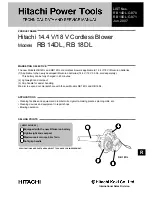
10
MODEL
RB24EAP
/
RB24EA
Engine Size (ml)
23.9
Spark Plug
NGK BMR7A
Dry weight (kg)
3.9
Fuel tank capacity (l)
0.52
Sound pressure level
LpA (dB (A))
by ISO22868
Uncertainty (dB (A))
By ANSI 69*
2
By CEN 87*
1
1.8*
1
Sound power level
Lw measured (dB (A))
by ISO22868
Sound power level LwA (dB (A))
by 2000/14/EC
107*
1
109*
1
Vibration level (m/s
2
)
by ISO22867
Uncertainty (m/s
2
)
12
1.0
*1: Equivalent noise level/vibration level are calculated as the time-
weighted energy total for noise/vibration levels under various
working conditions with the following time distribution: 1/7 Idle,
6/7 racing.
*2: ANSI B175.2
* All data subject to change without notice.
ASSEMBLY
PROCEDURES
Blow
pipes
to
main
body
(Fig.
1)
Inspect the main body and accessories.
Connect straight pipe (1) securely. Align projection (2) in straight
pipe with groove (3) on blower housing and slide the pipe into the
blower housing.
Rotate the pipe clockwise to lock it into place.
Conic
pipe
to
straight
pipe
(Fig.
2)
○
Align groove (5) on the conic pipe (6) and projection (4) on
straight pipe (1) and rotate the conic pipe in place.
OPERATING
PROCEDURES
Fuel
(Fig.
3)
WARNING
○
The unit/machine is equipped with a two-stroke engine. Always
run the engine on fuel, which is mixed with oil.
Provide good ventilation, when fueling or handling fuel.
○
Fuel contains highly
fl
ammable and it is possible to get the
serious personal injury when inhaling or spilling on your body.
Always pay attention when handling fuel. Always have good
ventilation when handling fuel inside building.
Fuel
○
Always use branded 89 octane unleaded gasoline.
○
Use genuine two-cycle oil or use a mix between 25:1 to 50:1,
please consult the oil bottle for the ratio or Hitachi dealer.
○
If genuine oil is not available, use an anti-oxidant added quality
oil expressly labeled for air-cooled 2-cycle engine use (JASO
FC GRADE OIL or ISO EGC GRADE). Do not use BIA or TCW
(2-stroke water-cooling type) mixed oil.
○
Never use for four-stroke engine oil or waste oil.
○
Always mix fuel and oil in a separate clean container.
Always start by
fi
ling half the amount of fuel, which is to be used.
Then add the whole amount of oil. Mix (shake) the fuel mixture. Add
the remaining amount of fuel.
Mix (shake) the fuel-mix thoroughly before
fi
lling the fuel tank.
Fueling
WARNING
○
Always shut o
ff
the engine and let it cool for a few minutes
before refueling.
○
Slowly open the fuel tank, when
fi
lling up with fuel, so that
possible over-pressure disappears.
○
Tighten the fuel cap carefully, after fueling.
○
Always move the unit at least 3 m from the fueling area before
starting.
○
Do not smoke and/or allow
fl
ames or sparks near fuel when
handling or
fi
lling fuel.
○
Always wash any spilled fuel from clothing immediately with
soap.
○
Be sure to check for any fuel leakage after refueling.
Before fueling, clean the tank cap area carefully, to ensure that
no dirt falls into the tank. Make sure that the fuel is well mixed by
shaking the container, before fueling.
Starting
CAUTION
Do not start if the pipe and guard net is obstructed.
1. Check the switch (7) to ON position. (
Fig.
4
)
* Push priming bulb (8) several times so that fuel
fl
ows through
the bulb or return pipe (9). (
Fig.
5
)
2. Set choke lever to CLOSED position. (
Fig.
6
)
3. Pull recoil starter briskly, taking care to keep the handle in your
grasp and not allowing it to snap back. (
Fig.
7
)
4. When you hear the engine want to start, return choke lever to
RUN position (open). Then pull recoil starter briskly again.
WARNING
○
Never start or run the engine inside a closed room or building
and/or near the in
fl
ammable liquid. Breathing exhaust fumes
can kill.
○
Do not allow the rope to snap back in and always hold the unit
fi
rmly.
NOTE
If engine does not start, repeat procedures from 2 to 4.
5. After starting engine, allow the engine about 2–3 minutes to
warm up before subjecting it to any load.
* If the engine stops and is hard to restart straightaway, allow it
to cool before trying again.
Operating
blower
(Fig.
8)
○
A low speed should be used to blow leaves and dry grass.
○
A medium speed should be used to clean wet leaves and grass.
○
A high speed should be used when moving gravel, dirt or other
heavy materials.
WARNING
○
Do not direct discharge of air toward people or pet.
○
The unit should be operated in a well ventilated area.
○
Never perform assembly or disassembly procedures with
engine running or serious personal injury may result.
○
Never touch mu
ffl
er, spark plug, or other metallic parts while
engine is in running or immediately after shutting o
ff
engine.
SPECIFICATIONS
000Book̲RB24EAP̲ChS.indb 10
000Book̲RB24EAP̲ChS.indb 10
2010/06/18 12:06:59
2010/06/18 12:06:59
Содержание RB 24EA
Страница 12: ...12 000Book RB24EAP ChS indb 12 000Book RB24EAP ChS indb 12 2010 06 18 12 07 00 2010 06 18 12 07 00 ...
Страница 13: ...13 000Book RB24EAP ChS indb 13 000Book RB24EAP ChS indb 13 2010 06 18 12 07 01 2010 06 18 12 07 01 ...
Страница 14: ...14 000Book RB24EAP ChS indb 14 000Book RB24EAP ChS indb 14 2010 06 18 12 07 01 2010 06 18 12 07 01 ...
Страница 15: ...15 000Book RB24EAP ChS indb 15 000Book RB24EAP ChS indb 15 2010 06 18 12 07 01 2010 06 18 12 07 01 ...


































